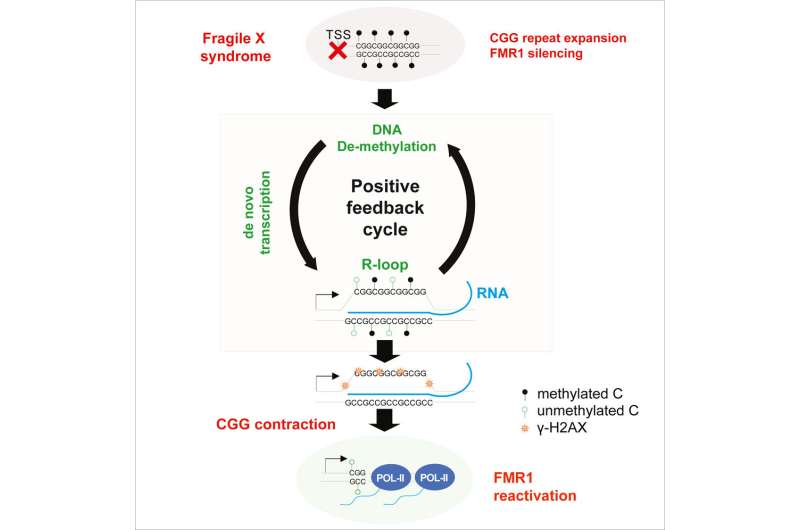This article has been reviewed according to Science X's editorial process and policies. Editors have highlighted the following attributes while ensuring the content's credibility:
fact-checked
peer-reviewed publication
trusted source
proofread
Novel approach that stimulates cells' DNA repair mechanisms may combat a leading cause of autism spectrum disorders

New research has identified a potential method for treating fragile X syndrome, a leading cause of autism spectrum disorders that is characterized by an inherited repeat of certain nucleotides within the DNA sequence of the FMR1 gene. The work, which was conducted by investigators at Massachusetts General Hospital (MGH), is published in the journal Cell.
FXS is caused by an expansion of the trinucleotide repeat CGG within FMR1, which stands for Fragile X Messenger Ribonucleoprotein 1. FMR1 makes a protein called FMRP that is needed for brain development, but the CGG expansion in people born with FXS leads to reduced expression of this protein, leading to developmental delays, learning disabilities, and social and behavior problems. The disorder affects 1 in 3,000 boys and 1 in 6,000 girls.
"We wondered if we could treat FXS by contracting the trinucleotide repeat in FMR1 and restoring FMRP expression," explains senior author Jeannie T. Lee, MD, Ph.D., a molecular biologist at MGH and a professor of Genetics at Harvard Medical School. "While the industry is trying to restore expression by gene therapy and gene editing, our approach was to contract the CGG repeat and restore protein expression by stimulating the body's own DNA repair mechanisms."
By generating models derived from the cells of patients with FXS and exposing the models to different laboratory conditions, Lee and postdoctoral fellow and first author, Hun-Goo Lee, Ph.D., discovered conditions that induce a strong repeat contraction and full FMR1 reactivation. The conditions required the presence of inhibitors of two kinases called MEK and BRAF.
Inhibiting these enzymes led to enhanced production of special nucleic acid structures called "R-loops" formed between DNA and RNA, which cells see as DNA damage and therefore trigger repair mechanisms to fix the problem. The cells' repair mechanisms then excise the expanded CGG repeats to achieve more normal CGG levels, enabling cells to re-express the crucial FMR1 gene.
"Because the disease is caused by the expanded CGG repeat, contracting the repeat through R-loop formation is potentially a one-and-done treatment," says Lee. "We are now extending the technology to patient neurons and to the brain in animal models."
Additional co-authors include Sachiko Imaichi, Elizabeth Kraeutler, Rodrigo Aguilar, Yong-Woo Lee, and Steven D. Sheridan.
More information: Hun-Goo Lee et al, Site-specific R-loops induce CGG repeat contraction and fragile X gene reactivation, Cell (2023). DOI: 10.1016/j.cell.2023.04.035




















